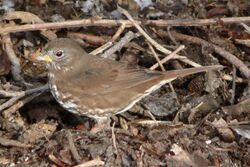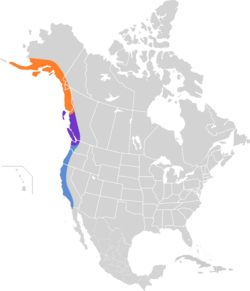Biology:Sooty fox sparrow
| Passerella iliaca unalaschcensis | |
|---|---|

| |
| Passerella (iliaca) unalaschcensis in the state of Washington (state) | |
| Scientific classification | |
| Domain: | Eukaryota |
| Kingdom: | Animalia |
| Phylum: | Chordata |
| Class: | Aves |
| Order: | Passeriformes |
| Family: | Passerellidae |
| Genus: | Passerella |
| Species: | |
| Subspecies: | P. i. unalaschcensis
|
| Trinomial name | |
| Passerella iliaca unalaschcensis (Gmelin, 1789)
| |

| |
Breeding Year-round Nonbreeding
| |
The sooty fox sparrow (Passerella (iliaca) unalaschcensis) contains the darkest-colored taxa in the genus Passerella. It is currently classified as a "subspecies group"[1] within the fox sparrow pending wider-spread acceptance of species status. It has long been suspected to be a separate evolutionary lineage due to morphological distinctness (Swarth 1920), and this is confirmed by analysis of mtDNA sequence and haplotype data (Zink 1994, Zink & Kessen 1999, Zink & Weckstein 2003). This group appears to be most closely related to the thick-billed and/or slate-colored fox sparrows (Zink 1996, Zink & Weckstein 2003).
Description
The sooty fox sparrow complex varies clinally in intensity of color. The upperparts and head are a variable shade of brown, with streaks on the underparts of the same color. The northernmost birds are a sandy brown, while southernmost birds are a dark coffee-like color. Sooties prefer to breed in willows and alders at the edge of wet habitats. Beadle & Rising (2003) describe their call note as a sharp zitt or thik, while Sibley (2000) says it is a loud smack like that of the red fox sparrow.
Subspecies
Six subspecies are usually recognized in the sooty fox sparrow complex, ranging from unalaschensis in the Aleutians to fuliginosa in extreme northwestern Washington:
- unalaschcensis (Gmelin, 1789):
- Breeds from Unalaska Island (Aleutian Islands) to the Shumagin and Semidi Islands and adjacent Alaska Peninsula. Winter range from south British Columbia to southernmost California , rarely even further south. (Weckstein et al. 2002)
- There are two distinct groups known from the winter range: brownish ash-gray birds with a longer and more pointed bill, and darker lead-gray birds with thicker, blunter bills; the taxonomic significance of this is unknown (Weckstein et al. 2002). Seems to intergrade with sinuosa and insularis where their ranges meet. (Swarth 1920)
- townsendi (Audubon, 1838):
- Breeds along the Pacific Coast from Glacier Bay to Haida Gwaii. Winter range south of breeding range, to central California. (Weckstein et al. 2002)
- Much darker and more rufous than unalaschcensis, with conspicuously larger and more plentiful breast spots similar to fuliginosa (Swarth 1920).
- fuliginosa Ridgway, 1899:
- Breeds on the mainland south from the Stikine River to northwestern Washington. Winter range from southwestern British Columbia south to coastal central California. (Weckstein et al. 2002)
- Darker and sootier than townsendi, with the largest and most plentiful breast spots (Weckstein et al. 2002).
- annectens Ridgway, 1900:
- Breeds along the Pacific Coast from northern Yakutat Bay to Cross Sound. Winter range coastal central California.(Weckstein et al. 2002)
- Intermediate between sinuosa and townsendi (Swarth, 1920). Morphology and range suggest its validity should be checked.
- insularis Ridgway, 1900:
- Breeding limited to Kodiak Island. In winter, found along the Pacific Coast southwards to southernmost California.(Weckstein et al., 2002)
- Brighter and more uniformly ruddy above, with strong and rich brown breast spots; under tail-coverts tinged buff (Weckstein et al. 2002).
- sinuosa Grinnell, 1910:
- Breeds around Prince William Sound and the Kenai Peninsula and on Middleton Island. In winter, south along Pacific slope of southern California. (Weckstein et al. 2002)
- Intermediate between unalaschcensis and insularis, but bill markedly more slender than in either (Weckstein et al. 2002).
- chilcatensis Webster, 1983:
- The "non-typical fuliginosa" of Swarth (1920), breeding between the Chilkat River area to Stewart and surroundings (British Columbia), and wintering along the coast, mainly between Oregon and the San Francisco Bay region (Weckstein et al., 2002).
- Much like fuliginosa, but duller and shorter-tailed. Not usually accepted as distinct by recent reviewers (e.g., Zink 1994, Rising & Beadle 1996, Zink & Kessen 1999), although the presence of similarly distinct birds in unalaschcensis suggests the matter warrants more research.
References
| Wikimedia Commons has media related to the sooty fox sparrow. |
- Beadle, David & Rising, Jim D. (2003): Sparrows of the United States and Canada : the photographic guide. Princeton University Press, Princeton. ISBN:0-691-11747-0 p. 174
- Rising, Jim D. & Beadle, David (1996): A Guide to the Identification and Natural History of the Sparrows of the United States and Canada. Academic Press, San Diego. ISBN:0-12-588971-2
- Sibley, David Allen (2000): The Sibley Guide to Birds. Alfred A. Knopf, New York. ISBN:0-679-45122-6
- Swarth H. W. (1920): Revision of the avian genus Passerella with special reference to the distribution and migration of the races in California. University of California Publications in Zoology 21: 75–224.
- Weckstein, J. D.; Kroodsma, D. E. & Faucett, R. C. (2002): Fox Sparrow (Passerella iliaca). In: Poole, A. & Gill, F. (eds.): The Birds of North America 715. Academy of Natural Sciences, Philadelphia, PA & American Ornithologists' Union, Washington, D.C. Online version, retrieved 2006-11-27. doi:10.2173/bna.715 (requires subscription)
- Zink, R. M. (1994): The Geography of Mitochondrial DNA Variation, Population Structure, hybridization, and Species Limits in the Fox Sparrow (Passerella iliaca). Evolution 48(1): 96-111. doi:10.2307/2410006 (HTML abstract, first page image)
- Zink, Robert M. & Kessen, A. E. (1999): Species Limits in the Fox Sparrow. Birding 31: 508–517.
- Zink, Robert M. & Weckstein, Jason D. (2003): Recent evolutionary history of the Fox Sparrows (Genus: Passerella). Auk 120(2): 522–527. [Article in English with Spanish abstract] DOI: 10.1642/0004-8038(2003)120[0522:REHOTF]2.0.CO;2 HTML fulltext (without images)
Wikidata ☰ Q7562787 entry
 |

